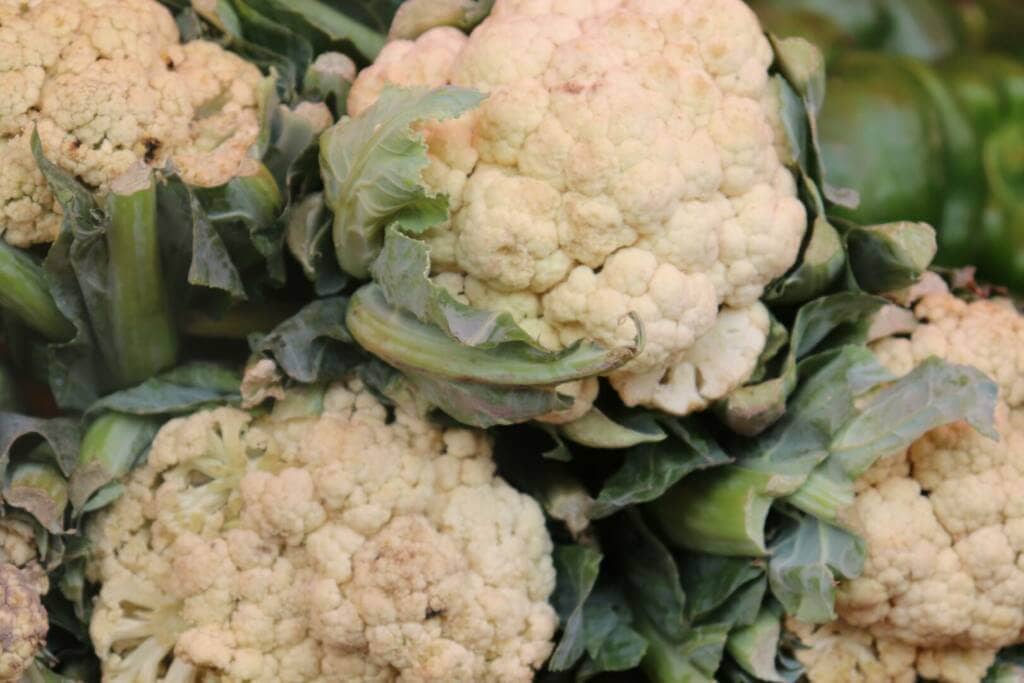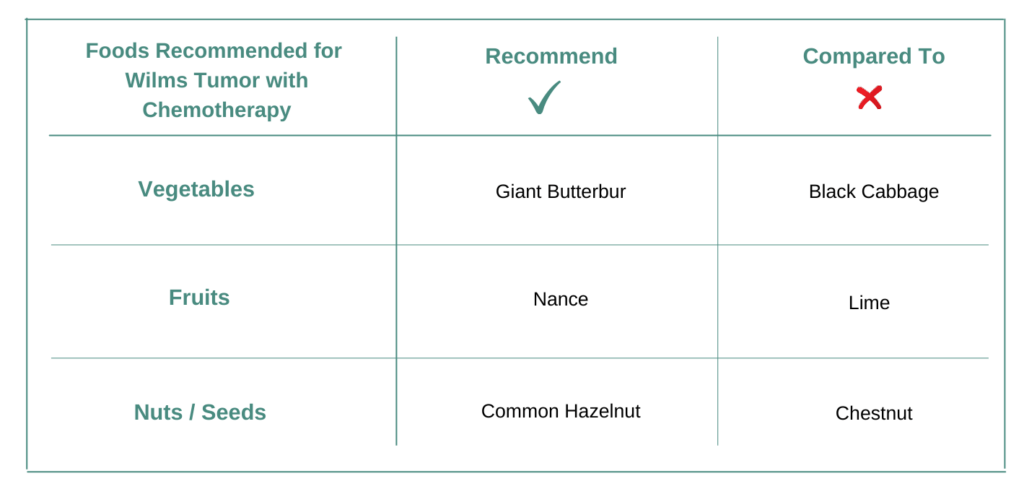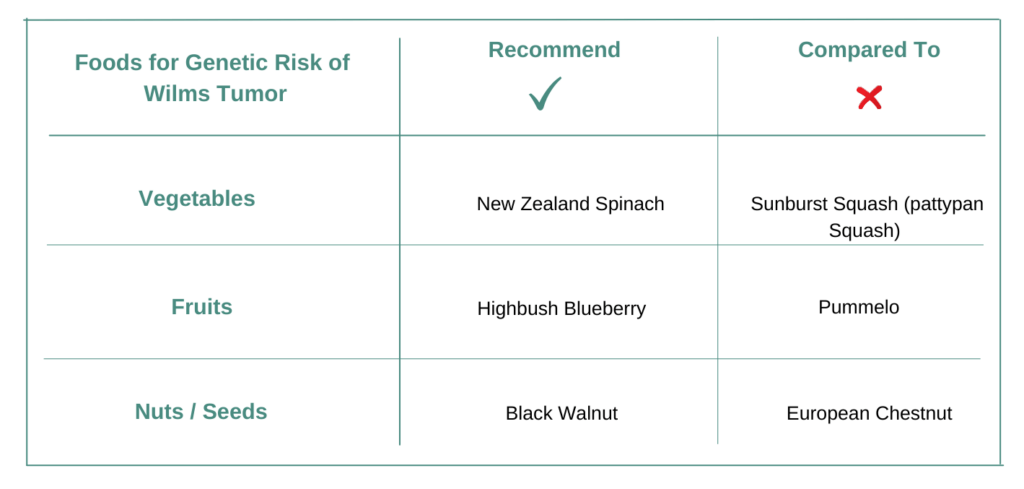Introduction
Foods for Wilms Tumor should be personalized for each individual and also must adapt when cancer treatment or tumor genetic change. The personalization and adaptation must consider all the active ingredients or bioactives contained in different foods with respect to cancer tissue biology, genetics, treatments, lifestyle conditions and diet preferences. Hence while nutrition is one of the very important decisions for a cancer patient and individual at risk of cancer to make – how to choose foods to eat is not an easy task.
Wilms tumor, also called nephroblastoma, is a rare type of kidney cancer that occurs in young children, that accounts for 95% of all malignant kidney tumors in patients under the age of 15 years. Wilms tumor can occur in one kidney or both kidneys and can spread to the rest of the body. There are about 650 new cases of Wilms tumor diagnosed in the United States each year, with the average age of diagnoses being 2 to 5 years. Incidence of Wilms tumor is slightly higher in girls when compared to boys. In younger children, the first sign of Wilms tumor is a large lump or mass in the abdomen, which can be associated with abdominal pain and swelling. In older children, symptoms may include pain, anemia, fever, blood in the urine, nausea, vomiting, constipation, loss of appetite, shortness of breath and high blood pressure. Staging of Wilms tumor is based on the spread of the tumor in the kidney or beyond the kidney. Mutations (genetic alterations) in genes such as WT1, CTNNB1 and WTX have been found to be altered in patients with Wilms tumor and changes in these genes could be responsible for the uncontrollable growth of the cells in the kidney. Treatment of Wilms tumor depends on the stage of the tumor and includes surgery, radiation therapy and combination chemotherapy regimens, that has improved the 5-year survival rate for Wilms tumor in the United States to 92%, but global rate of survival is only 78%. Supportive care with the right nutrition (foods and natural supplements) aligned with the treatment can enhance well-being of the patient.
For Wilms Tumor does it matter what vegetables, fruits, nuts, seeds one eats?
A very common nutrition question asked by cancer patients and individuals at-genetic risk of cancer is – for cancers like Wilms Tumor does it matter what foods I eat and which I do not? Or if I follow a plant-based diet is that enough for cancer like Wilms Tumor?
For example does it matter if vegetable Giant Butterbur is consumed more compared to Black Cabbage? Does it make any difference if fruit Lime is preferred over Nance? Also if similar choices are made for nuts/seeds like Common Hazelnut over Chestnut and for pulses like Adzuki Bean over Catjang Pea. And if what I eat matters – then how does one identify foods which are recommended for Wilms Tumor and is it the same answer for everyone with the same diagnosis or genetic risk?
Yes! Foods you eat matters for Wilms Tumor!
Food recommendations may not be the same for everyone and can be different even for the same diagnosis and genetic risk.

All foods (vegetables, fruits, nuts, seeds, pulses, oils etc.) and nutritional supplements are made up of more than one active molecular ingredient or bio-actives in different proportions and quantities. Each active ingredient has a unique mechanism of action – which can be activation or inhibition of different biochemical pathways. Simply stated foods and supplements which are recommended are those which do not cause an increase of molecular drivers of cancer but reduce them. Else those foods should not be recommended. Foods contain multiple active ingredients – hence when evaluating foods and supplements you need to consider the impact of all active ingredients cumulatively rather than individually.
For example Lime contains active ingredients Curcumin, Lycopene, Isoliquiritigenin, Naringin, Psoralen. And Nance contains active ingredients Curcumin, Isoliquiritigenin, Psoralen, Phloretin, Lupeol and possibly others.
A common mistake made when deciding and choosing foods to eat for Wilms Tumor – is to evaluate only selected active ingredients contained in foods and ignore the rest. Because different active ingredients contained in foods may have opposing effects on cancer drivers – you cannot cherry pick active ingredients in foods and supplements for making a nutrition decision for Wilms Tumor.
YES – FOOD CHOICES MATTER FOR CANCER. NUTRITION DECISIONS MUST CONSIDER ALL ACTIVE INGREDIENTS OF FOODS.
Skills Needed for Nutrition Personalization for Wilms Tumor?
Personalized nutrition for cancers like Wilms Tumor consists of recommended foods / supplements; not recommended foods / supplements with example recipes which prioritize use of recommended foods. An example of personalized nutrition can be seen at this link.
Deciding which foods are recommended or not is extremely complicated, requiring expertise in Wilms Tumor biology, food science, genetics, biochemistry along with good understanding of how cancer treatments work and associated vulnerabilities by which the treatments could stop being effective.
MINIMUM KNOWLEDGE EXPERTISE NEEDED FOR NUTRITION PERSONALIZATION FOR CANCER ARE: CANCER BIOLOGY, FOOD SCIENCE, CANCER TREATMENTS AND GENETICS.
Foods to Eat After Cancer Diagnosis!
No two cancers are the same. Go beyond the common nutrition guidelines for everyone and make personalized decisions about food and supplements with confidence.
Characteristics of cancers like Wilms Tumor
All cancers like Wilms Tumor can be characterized by a unique set of biochemical pathways – the signature pathways of Wilms Tumor. Biochemical pathways like Epithelial to Mesenchymal Transition, MAPK Signaling, Focal Adhesion, PI3K-AKT-MTOR Signaling are part of the signature definition of Wilms Tumor. Each individual’s cancer genetics can be different and hence their specific cancer signature could be unique.
The treatments which are effective for Wilms Tumor need to be cognizant of the associated signature biochemical pathways for each cancer patient and individual at genetic risk. Therefore different treatments with different mechanisms of actions are effective for different patients. Similarly and for the same reasons foods and supplements need to be personalized for each individual. Hence some foods and supplements are recommended for Wilms Tumor when taking cancer treatment Vincristine, and some foods and supplements are not recommended.
Sources like cBioPortal and many others provide population representative patient anonymized data from clinical trials for all cancer indications. This data consists of clinical trial study details like sample size / number of patients, age groups, gender, ethnicity, treatments, tumor site and any genetic mutations.
HLA-DQB1, MAP3K4, EPHA5, ACTB and NFE2L1 are the top ranked reported genes for Wilms Tumor. HLA-DQB1 is reported in 4.2 % of the representative patients across all clinical trials. And MAP3K4 is reported in 2.4 %. The combined population patient data cover ages from 1 to 28. 45.3 % of the patient data are identified as men. The Wilms Tumor biology along with reported genetics together define the population represented signature biochemical pathways for this cancer. If the individual cancer tumor genetics or genes contributing to the risk are also known then that should also be used for nutrition personalization.
NUTRITION CHOICES SHOULD MATCH WITH EACH INDIVIDUAL’S CANCER SIGNATURE.
Food and Supplements for Wilms Tumor
For Cancer Patients
Cancer patients on treatment or on palliative care need to make decisions on food and supplements – for the needed dietary calories, for managing any treatment side effects and also for improved cancer management. All plant-based foods are not equal and choosing and prioritizing foods which are personalized and customized to ongoing cancer treatment is important and complicated. Here are some examples providing guidelines for making nutrition decisions.
Choose Vegetable GIANT BUTTERBUR or BLACK CABBAGE?
Vegetable Giant Butterbur contains many active ingredients or bioactives such as Curcumin, Lycopene, Isoliquiritigenin, Psoralen, Phloretin. These active ingredients manipulate various biochemical pathways like Cell Cycle, Epithelial to Mesenchymal Transition, DNA Repair and Microtubule Dynamics and others. Giant Butterbur is recommended for Wilms Tumor when ongoing cancer treatment is Vincristine. This is because Giant Butterbur modifies those biochemical pathways which have been scientifically reported to sensitize the effect of Vincristine.
Some of the active ingredients or bioactives in vegetable Black Cabbage are Curcumin, Isoliquiritigenin, Psoralen, Phloretin, Lupeol. These active ingredients manipulate various biochemical pathways like Oxidative Stress and PI3K-AKT-MTOR Signaling and others. Black Cabbage is not recommended for Wilms Tumor when ongoing cancer treatment is Vincristine because it modifies those biochemical pathways which make the cancer treatment resistant or less responsive.
VEGETABLE GIANT BUTTERBUR IS RECOMMENDED OVER BLACK CABBAGE FOR Wilms Tumor AND TREATMENT Vincristine.
Choose Fruit NANCE or LIME?
Fruit Nance contains many active ingredients or bioactives such as Curcumin, Isoliquiritigenin, Psoralen, Phloretin, Lupeol. These active ingredients manipulate various biochemical pathways like Cell Cycle, Epithelial to Mesenchymal Transition, DNA Repair and Microtubule Dynamics and others. Nance is recommended for Wilms Tumor when ongoing cancer treatment is Vincristine. This is because Nance modifies those biochemical pathways which have been scientifically reported to sensitize the effect of Vincristine.
Some of the active ingredients or bioactives in fruit Lime are Curcumin, Lycopene, Isoliquiritigenin, Naringin, Psoralen. These active ingredients manipulate various biochemical pathways like Notch Signaling, WNT Beta Catenin Signaling and Oxidative Stress and others. Lime is not recommended for Wilms Tumor when ongoing cancer treatment is Vincristine because it modifies those biochemical pathways which make the cancer treatment resistant or less responsive.
FRUIT NANCE IS RECOMMENDED OVER LIME FOR Wilms Tumor AND TREATMENT Vincristine.
Choose Nut COMMON HAZELNUT or CHESTNUT?
Common Hazelnut contains many active ingredients or bioactives such as Curcumin, Lycopene, Quercetin, Isoliquiritigenin, Psoralen. These active ingredients manipulate various biochemical pathways like Cell Cycle, Epithelial to Mesenchymal Transition, Carbohydrate Metabolism and DNA Repair and others. Common Hazelnut is recommended for Wilms Tumor when ongoing cancer treatment is Vincristine. This is because Common Hazelnut modifies those biochemical pathways which have been scientifically reported to sensitize the effect of Vincristine.
Some of the active ingredients or bioactives in Chestnut are Curcumin, Lycopene, Isoliquiritigenin, Psoralen, Phloretin. These active ingredients manipulate various biochemical pathways like Epithelial to Mesenchymal Transition, WNT Beta Catenin Signaling and Oxidative Stress and others. Chestnut is not recommended for Wilms Tumor when ongoing cancer treatment is Vincristine because it modifies those biochemical pathways which make the cancer treatment resistant or less responsive.
COMMON HAZELNUT IS RECOMMENDED OVER CHESTNUT FOR Wilms Tumor AND TREATMENT Vincristine.

For Individuals with Genetic Risk of Cancer
The question asked by individuals who have genetic risk of Wilms Tumor or familial history is “What Should I Eat Differently from Before?” and how they should choose foods and supplements to manage risks of the disease. Since for cancer risk there is nothing actionable in terms of treatment – decisions of foods and supplements become important and one of the very few actionable things which can be done. All plant-based foods are not equal and based on identified genetics and pathway signature – the choices of food and supplements should be personalized.
Choose Vegetable NEW ZEALAND SPINACH or SUNBURST SQUASH (PATTYPAN SQUASH)?
Vegetable New Zealand Spinach contains many active ingredients or bioactives such as Curcumin, Apigenin, Quercetin, Lupeol, Lycopene. These active ingredients manipulate various biochemical pathways like Inflammation, P53 Signaling, MAPK Signaling and MYC Signaling and others. New Zealand Spinach is recommended for risk of Wilms Tumor when associated genetic risk is ACTB. This is because New Zealand Spinach increases those biochemical pathways which counteract the signature drivers of it.
Some of the active ingredients or bioactives in vegetable Sunburst Squash (pattypan Squash) are Curcumin, Apigenin, Lupeol, Phloretin, Beta-sitosterol. These active ingredients manipulate various biochemical pathways like WNT Beta Catenin Signaling and Oncogenic Cancer Epigenetics and others. Sunburst Squash (pattypan Squash) is not recommended when risk of Wilms Tumor when associated genetic risk is ACTB because it increases the signature pathways of it.
VEGETABLE NEW ZEALAND SPINACH IS RECOMMENDED OVER SUNBURST SQUASH (PATTYPAN SQUASH) FOR ACTB GENETIC RISK OF CANCER.
Choose Fruit HIGHBUSH BLUEBERRY or PUMMELO?
Fruit Highbush Blueberry contains many active ingredients or bioactives such as Curcumin, Apigenin, Quercetin, Lupeol, Lycopene. These active ingredients manipulate various biochemical pathways like Inflammation, P53 Signaling, Focal Adhesion and MAPK Signaling and others. Highbush Blueberry is recommended for risk of Wilms Tumor when associated genetic risk is ACTB. This is because Highbush Blueberry increases those biochemical pathways which counteract the signature drivers of it.
Some of the active ingredients or bioactives in fruit Pummelo are Curcumin, Apigenin, Quercetin, Lupeol, Lycopene. These active ingredients manipulate various biochemical pathways like WNT Beta Catenin Signaling and Cell Cycle Checkpoints and others. Pummelo is not recommended when risk of Wilms Tumor when associated genetic risk is ACTB because it increases the signature pathways of it.
FRUIT HIGHBUSH BLUEBERRY IS RECOMMENDED OVER PUMMELO FOR ACTB GENETIC RISK OF CANCER.
Choose Nut BLACK WALNUT or EUROPEAN CHESTNUT?
Black Walnut contains many active ingredients or bioactives such as Curcumin, Apigenin, Quercetin, Lupeol, Ellagic Acid. These active ingredients manipulate various biochemical pathways like Inflammation, P53 Signaling, Cytoskeletal Dynamics and MYC Signaling and others. Black Walnut is recommended for risk of Wilms Tumor when associated genetic risk is ACTB. This is because Black Walnut increases those biochemical pathways which counteract the signature drivers of it.
Some of the active ingredients or bioactives in European Chestnut are Curcumin, Apigenin, Quercetin, Lupeol, Ellagic Acid. These active ingredients manipulate various biochemical pathways like WNT Beta Catenin Signaling and Oncogenic Cancer Epigenetics and others. European Chestnut is not recommended when risk of Wilms Tumor when associated genetic risk is ACTB because it increases the signature pathways of it.
BLACK WALNUT IS RECOMMENDED OVER EUROPEAN CHESTNUT FOR ACTB GENETIC RISK OF CANCER.

In Conclusion
Foods and Supplements chosen are important decisions for cancers like Wilms Tumor. Wilms Tumor patients and individuals with genetic-risk always have this question: “What foods and nutritional supplements are recommended for me and which are not?” There is a common belief which is a misconception that all plant-based foods could be beneficial or not but would not be harmful. Certain foods and supplements can interfere with cancer treatments or promote molecular pathway drivers of cancer.
There are different types of cancer indications like Wilms Tumor, each with different tumor genetics with further genomic variations across each individual. Further every cancer treatment and chemotherapy has a unique mechanism of action. Each food like Giant Butterbur contains various bioactives in different quantities, which have an impact on different and distinct sets of biochemical pathways. The definition of personalized nutrition is individualized food recommendations for the cancer indication, treatments, genetics, lifestyle and other factors. Nutrition personalization decisions for cancer require knowledge of cancer biology, food science and an understanding of different chemotherapy treatments. Finally when there are treatment changes or new genomics is identified – the nutrition personalization needs re-evaluation.
The addon nutrition personalization solution makes the decision making easy and removes all the guesswork in answering the question, “What foods should I choose or not choose for Wilms Tumor?”. The addon multi-disciplinary team includes cancer physicians, clinical scientists, software engineers and data scientists.
Personalized Nutrition for Cancer!
Cancer changes with time. Customize and modify your nutrition based on cancer indication, treatments, lifestyle, food preferences, allergies and other factors.
References
- Mixed Kunga Msk 2022
- Cancer therapy shapes the fitness landscape of clonal hematopoiesis.
- Preventive effects of butyric acid, nicotinamide, calcium glucarate alone or in combination during the 7, 12-dimethylbenz (a) anthracene induced mouse skin tumorigenesis via modulation of K-Ras-PI3K-AKTpathway and associated micro RNAs.
- Hesperetin, a potential therapy for carcinoid cancer.
- α-Terpineol reduces cancer pain via modulation of oxidative stress and inhibition of iNOS.
- Protective versus promotional effects of white tea and caffeine on PhIP-induced tumorigenesis and beta-catenin expression in the rat.
- (+)-Catechin inhibits intestinal tumor formation and suppresses focal adhesion kinase activation in the min/+ mouse.
- α-pinene regulates miR-221 and induces G2/M phase cell cycle arrest in human hepatocellular carcinoma cells.
- Geraniol, a component of plant essential oils, sensitizes human colonic cancer cells to 5-Fluorouracil treatment.
- https://www.ncbi.nlm.nih.gov/books/NBK442004
- https://rarediseases.org/rare-diseases/wilms-tumor
